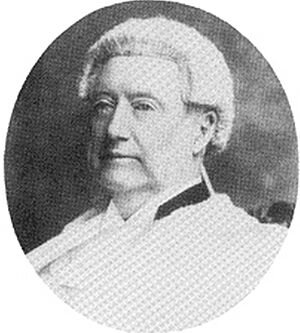Cloncorrick, Darling Point facts for kids
Quick facts for kids Cloncorrick |
|
|---|---|

Cloncorrick, Darling Point
|
|
| General information | |
| Status | Complete |
| Type | House |
| Architectural style | Victorian Free Gothic |
| Location | 1 Annandale Street, Darling Point, New South Wales |
| Country | Australia |
| Coordinates | 33°52′26″S 151°14′10″E / 33.8738°S 151.2362°E |
| Named for | Cloncorrick Castle, Ireland |
| Completed | 1884 |
| Client | Sir George Bowen Simpson |
| Technical details | |
| Material | Brick |
| Floor count | 3 |
| Design and construction | |
| Architect | John Horbury Hunt |
| Official name | Cloncorrick |
| Designated | 21 March 1978 |
| Part of | St Mark's Church group |
| Reference no. | 2480 |
|
Invalid designation
|
|
| Official name | Cloncorrick - house, street fencing |
| Type | Built |
| Criteria | a., c., f., g. |
| Designated | 10 March 1995 |
| Reference no. | Local register |
Cloncorrick is a beautiful old house in Darling Point, a suburb of Sydney, Australia. It was built in 1884 for Sir George Bowen Simpson. The house was designed by a famous architect named John Horbury Hunt. It's built in a special style called Victorian Free Gothic.
Sir George named the house after Cloncorrick Castle in Ireland. His grandfather used to live there. Over the years, many important Australians have lived in Cloncorrick. Today, the house has been divided into two apartments.
Contents
Why is Cloncorrick Special?
Cloncorrick is a very important historical building. It is listed on the heritage register because of its history and unique design. This means it's protected so future generations can enjoy it.
The house is important for several reasons:
- It's part of an original land grant from 1835.
- It was one of the first homes built in the area.
- It was built for Sir George Simpson, a well-known local figure.
- It shows how the Darling Point area grew over time.
- It was designed by the famous American architect John Horbury Hunt.
- It's a great example of a Victorian Free Gothic home.
- Its design and location make it stand out in the area.
Who Lived at Cloncorrick?
Many interesting people have called Cloncorrick home. Let's learn about some of them.
Sir George and Lady Simpson
George Bowen Simpson was born in 1838 near Parramatta. His father was a police officer. George went to Kings School, Parramatta. In 1858, he became a lawyer.
In 1861, George married Martha Margaret Cobcroft. They had two children, but sadly, both died young. This meant they had no children to inherit their home directly.
George became a very successful lawyer. In 1867, he became a judge. Later, in 1885, he became a politician in the New South Wales government. He even became the Attorney-General, which is a top legal advisor to the government. In 1894, he became a judge of the Supreme Court.
In 1909, he was given the title "Sir" (knighted) for his important work. He retired in 1910 due to poor health. Sir George spent his last years at Cloncorrick and passed away in 1915.
His wife, Martha, known as Lady Simpson, continued to live at Cloncorrick after his death. She was very involved with St Marks Church in Darling Point. Lady Simpson died in 1933 at the age of 90. A special plaque was placed in St Marks Church to remember both Sir George and Lady Simpson.
Since they had no direct children, their grandson, Julian Simpson, inherited the house. He sold Cloncorrick in 1934 to Esther Holt.
Esther Jane Holt
Esther Jane Holt was the wife of Walter Henry Holt. Walter was a wealthy pastoralist, which means he owned large farms or ranches. He had passed away in 1916. Esther was born in Wales in 1867.
Esther married Walter Holt in 1892. They lived in a huge mansion called Glanwyre in Manly. When Walter died, Esther divided up the Glanwyre estate and sold parts of it. This gave her a lot of money.
When Esther bought Cloncorrick in 1934, a newspaper advertisement described the house. It said the house had two stories plus a basement. It had wide verandahs and balconies. Inside, there was a large entrance hall, living rooms, a sewing room, and a pantry on the ground floor. Upstairs, there were four bedrooms and bathrooms. The basement had more rooms, including a kitchen, laundry, and a wine cellar.
Esther's daughter, Sophia, lived with her mother at Cloncorrick for some years. Esther died at Cloncorrick in 1948 when she was 81. In her will, she left a lot of money to St Marks Church and other charities.
Herbert and Meredith Lloyd
Herbert William Lloyd was born in 1883 in Melbourne. He joined the military in 1910. In May 1914, Herbert married Meredith Pleasents.
A few months after their wedding, World War I began. Herbert went to Egypt and then to Gallipoli. He was promoted to a higher rank there. He received special awards for his bravery during the war. After the war, he stayed in the military until 1925.
In 1929, Herbert became a politician in the New South Wales government. He worked there until 1941. When World War II started, he rejoined the military. He was promoted to a very high rank, Major General. He retired in 1946 after the war ended.
Herbert and Meredith lived at Cloncorrick. Meredith passed away there in 1952. Herbert continued to live in the house for some time after her death. He died in 1957 at the age of 74.




